Discover 11 hidden attractions, cool sights, and unusual things to do in Dunster (United Kingdom). Don't miss out on these must-see attractions: Dunster Castle, Dunster Working Watermill, and Gallox Bridge. Also, be sure to include Priory Church of St George in your itinerary.
Below, you can find the list of the most amazing places you should visit in Dunster (England).
Table of Contents
Dunster Castle

Castle in England. Dunster Castle is a former motte and bailey castle, now a country house, in the village of Dunster, Somerset, England. The castle lies on the top of a steep hill called the Tor, and has been fortified since the late Anglo-Saxon period. After the Norman conquest of England in the 11th century, William de Mohun constructed a timber castle on the site as part of the pacification of Somerset. A stone shell keep was built on the motte by the start of the 12th century, and the castle survived a siege during the early years of the Anarchy. At the end of the 14th century the de Mohuns sold the castle to the Luttrell family, who continued to occupy the property until the late 20th century.
The castle was expanded several times by the Luttrell family during the 17th and 18th centuries; they built a large manor house within the Lower Ward of the castle in 1617, and this was extensively modernised, first during the 1680s and then during the 1760s. The medieval castle walls were mostly destroyed following the siege of Dunster Castle at the end of the English Civil War, when Parliament ordered the defences to be slighted to prevent their further use. In the 1860s and 1870s, the architect Anthony Salvin was employed to remodel the castle to fit Victorian tastes; this work extensively changed the appearance of Dunster to make it appear more Gothic and Picturesque.
Following the death of Alexander Luttrell in 1944, the family was unable to afford the death duties on his estate. The castle and surrounding lands were sold off to a property firm, the family continuing to live in the castle as tenants. The Luttrells bought back the castle in 1954, but in 1976 Colonel Walter Luttrell gave Dunster Castle and most of its contents to the National Trust, which operates it as a tourist attraction. It is a Grade I listed building and scheduled monument.[1]
Address: Church St, TA24 6SL Dunster
Dunster Working Watermill

Dunster Working Watermill is a restored 18th century watermill, situated on the River Avill, close to Gallox Bridge, in the grounds of Dunster Castle in Dunster, Somerset, England. It is a Grade II* listed building.
The mill stands on a site where a mill was first recorded in the Domesday Book, but the present building was constructed around 1780. It closed in 1962 but was restored in 1979 and is still used to grind flour. The equipment is powered by two overshot wheels. It is owned and run by the National Trust.[2]
Address: 7 Mill Lane, TA24 6SW Dunster
Gallox Bridge
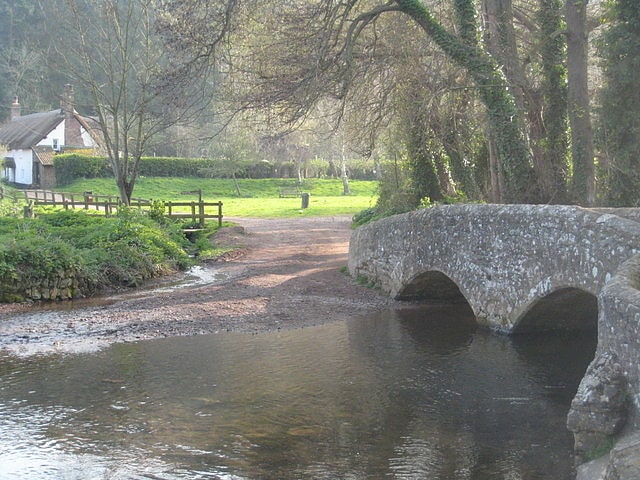
Bridge. The Gallox Bridge in Dunster, Somerset, England dates from the 15th century. It has been designated as a Grade I listed building and scheduled monument. The bridge is in the guardianship of English Heritage.
The stone packhorse bridge crosses the River Avill at the southern end of the village, below Dunster Castle at a point which may have been the limit of tidal flow during the medieval period. It was important for the transport of wool and other goods to the market within the village which was established by 1222. The name is derived from the nearby gallows. The narrow bridge is approach via a raised causeway for pedestrians, while wheeled traffic uses the adjacent ford.[3]
Priory Church of St George
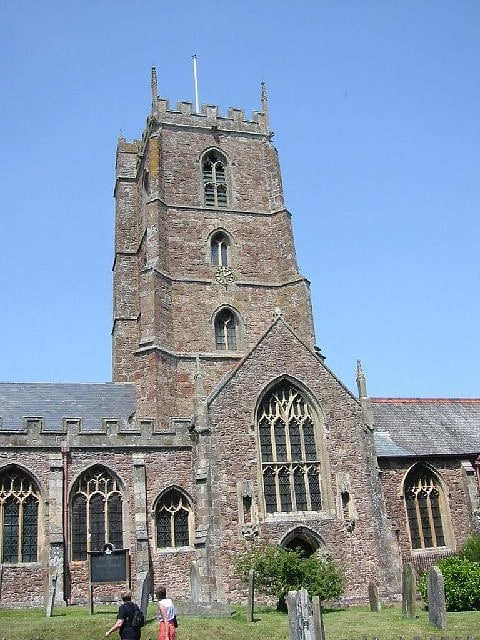
Building in Dunster, England. The Priory Church of St George in Dunster, Somerset, England, is predominantly 15th-century with evidence of 12th- and 13th-century work. It has been designated as a Grade I listed building.[4]
Address: Church St, TA24 6SH Minehead
Dunster Butter Cross
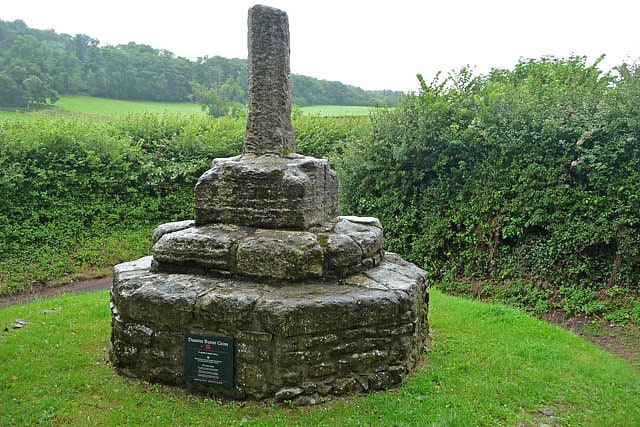
Historical landmark in Dunster, England. The Butter Cross in Dunster within the English county of Somerset is a Grade II* listed building and ancient monument. The cross was originally erected in the late 14th or early 15th century in the main street, and was moved to its current site in the late 18th or early 19th century. Although the head of the cross is missing, the shaft and socket stone are original. The cross is in the care of English Heritage and is managed by the National Trust.[5]
Yarn Market
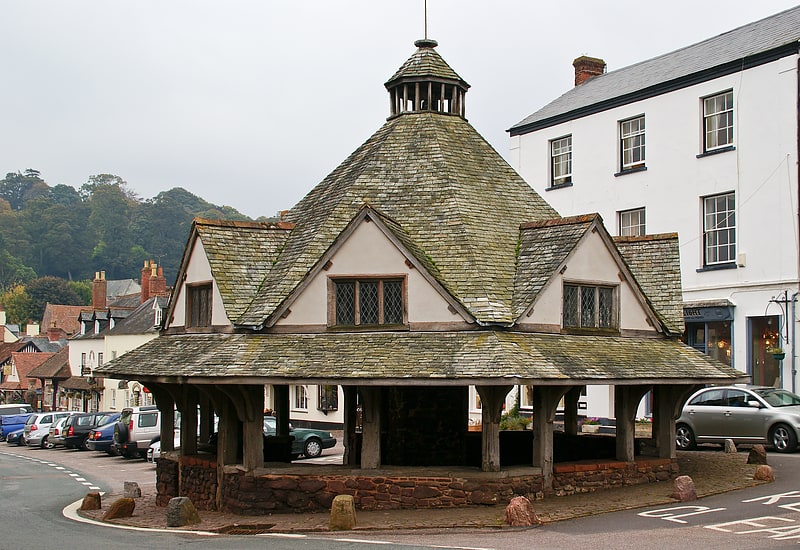
Historical place museum in Dunster, England. The Yarn Market in Dunster, Somerset, England was built in the early 17th century. It has been designated as a Grade I listed building and scheduled monument. Dunster was an important market place in the Middle Ages particularly following the construction of Dunster Castle and the establishment of the Priory Church of St George.
The market cross was probably built in 1609 by the Luttrell family who were the local lords of the manor to maintain the importance of the village as a market, particularly for wool and cloth. It still bears the damage caused by cannon fire in the Civil War. Nearby was an older cross known as the Butter Cross which has subsequently been moved to the outskirts of the village. The Yarn Market is an octagonal building constructed around a central pier. The tiled roof provides shelter from the rain.[6]
Address: High Street, TA24 6SF Dunster
Conygar Tower
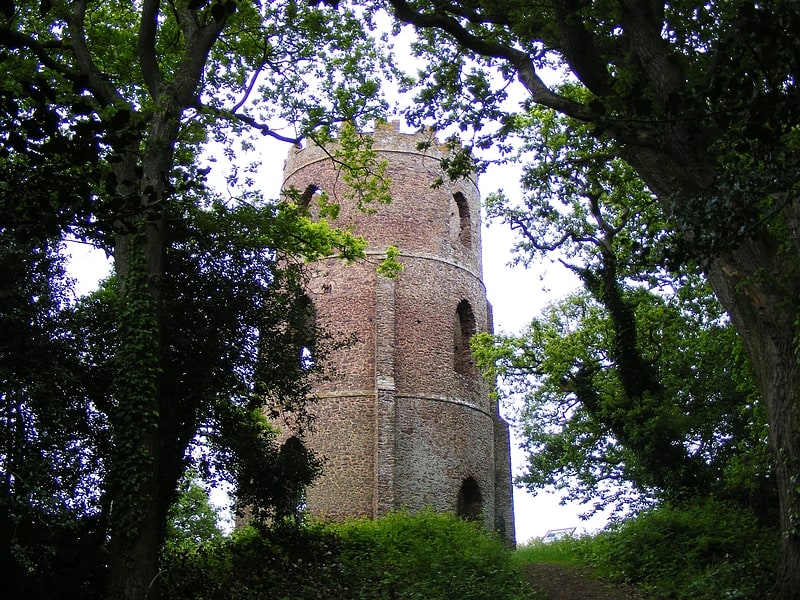
Tower in Dunster, England. The Conygar Tower in Dunster, Somerset, England was built in 1775 and has been designated as a Grade II listed building.
It is a circular, 3 storey folly tower built of red sandstone, situated on a hill overlooking the village. It was commissioned by Henry Luttrell and designed by Richard Phelps and stands about 18 metres (59 ft) high so that it can be seen from Dunster Castle on the opposite hillside. There is no evidence that it ever had floors or a roof.
The name Conygar comes from two medieval words Coney meaning rabbit and Garth meaning garden, indicating that it was once a warren where rabbits were bred for food.
In 1997 a survey carried out by The Crown Estate identified cracks in the walls which were repaired in 2000.[7]
Dunster Dovecote
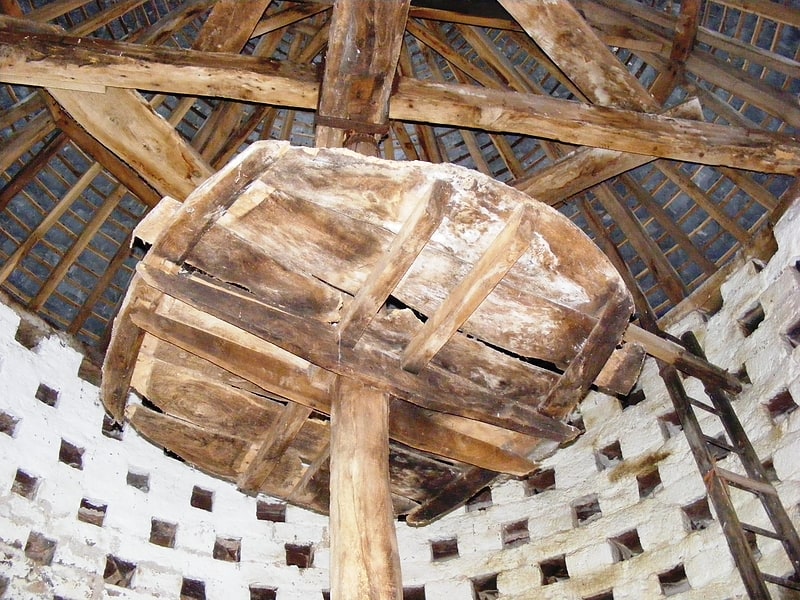
Historical landmark in Dunster, England. The Dovecote in Dunster, Somerset, England was probably built in the late 16th century. It has been designated as a Grade II* listed building and Scheduled Ancient Monument.
It is situated on Priory Green opposite the Tithe Barn and close to the walls of the Priory Church of St George. It is approximately 19 feet (5.8 m) high and 19 feet (5.8 m) in diameter, with walls around 4 feet (1.2 m) thick. There are five hundred and forty nest-holes.
There is no documentary evidence for the dovecote's date of construction but it some of the architectural features suggest it may have been as long ago as the 14th century. It would originally have belonged to the Benedictine Priory of Dunster which was a cell of Bath Abbey. Domestic pigeons were kept to provide squabs a luxury food from the breast meat of young pigeons. From the 12th century until 1619, only lords of the manor and parish priests were allowed to keep them. The priory was abolished in the dissolution of the monasteries in 1539, and property belonging to it was sold to the Luttrell family of Dunster Castle.
In the 18th century the floor level and door were raised among several major alterations. The lower tiers of nest holes were blocked to protect against brown rats which had arrived in the Britain in 1720 and reached Somerset by 1760. A revolving ladder, known as a "potence", was installed to allow the pigeon keeper to search the nest holes more easily. In the 19th century two feeding platforms were added to the axis of the revolving ladder. When the ladder was installed in the 16th century the base rests on a pin driven into a beam on the floor. The head of the pin sits in a metal cup in the base of the wooden pillar, which means the mechanism has never had to be oiled.
When the Dunster Castle estate was sold the dovecote was bought by the Parochial church council and opened to the public. Extensive repairs were undertaken in 1989.[8]
Dunster Priory
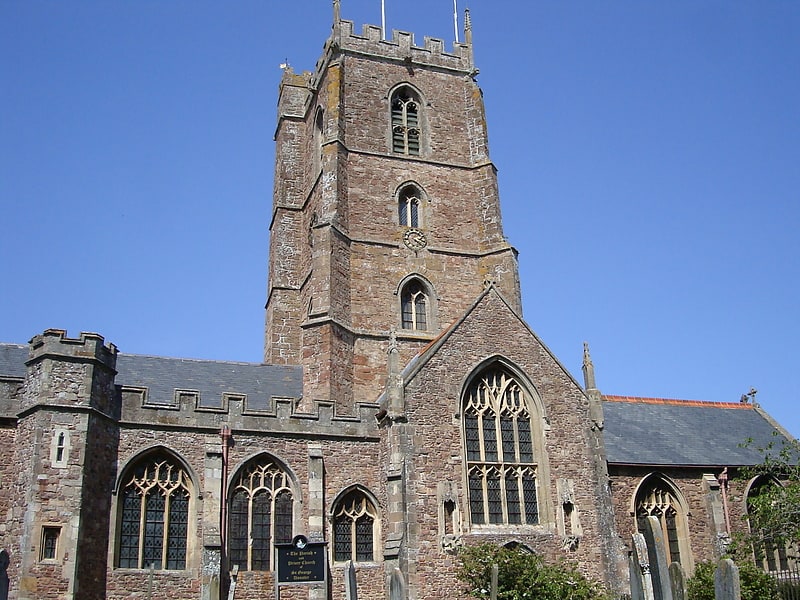
Monastery. Dunster Priory was established as a Benedictine monastery around 1100 in Dunster, Somerset, England.
The first church in Dunster was built by William de Mohun who gave the church and the tithes of several manors and two fisheries, to the Benedictine Abbey at Bath. The priory, which was situated just north of the church, became a cell of the abbey. The church was shared for worship by the monks and the parishioners, however this led to several conflicts between them. One outcome was the carved rood screen which divided the church in two with the parish using the west chancel and the monks the east. The priory church is now in parochial use as the Priory Church of St George which still contains 12th and 13th century work, although most of the current building is from the 15th century. It has been designated as a Grade I listed building.
By 1291 the priory had income from lands and rents of £5 13s. 3d. and from churches and ecclesiastical dues of £13 7s. 4d. according to the taxatio of Pope Nicholas IV. In 1332 it became more separated from the Abbey at Bath and became a priory in its own right. In the "Valor Ecclesiasticus" of 1535 the net annual income of the Dunster Tithe Barn is recorded as being £37.4.8d (£37 23p), with £6.13s7d (£6.68p) being passed on to the priory in Bath.
The Dunster Dovecote, on Priory Green opposite the Tithe Barn, is approximately 19 feet (5.8 m) high and 19 feet (5.8 m) in diameter, with walls around 4 feet (1.2 m) thick. There are five hundred and forty nest-holes. It would originally have belonged to the priory. Domestic pigeons were kept to provide squabs, a luxury food from the breast meat of young pigeons. From the 12th century until 1619, only Lords of the Manor and parish priests were allowed to keep them.
The tithe barn itself, a grade II listed building, dates from the 14th century but has been much altered and only a limited amount of the original features survive. It has a cruciform plan. The east front has central double doors of heavy oak with a chamfered frame. The Somerset Buildings Preservation Trust (SBPT) has co-ordinated a £550,000 renovation project to turn it into a multi-purpose community hall under a 99-year lease at a pepper-corn rent, by the Crown Estate Commissioners who own the building.
In 1346 Cleeve Abbey built a nunnery in Dunster, but it was never inhabited by nuns and was used as a guest house. The former guest house of Dunster Priory, which was built in the 15th century, is now the Luttrell Arms Hotel.
The priory was dissolved as part of the dissolution of the monasteries in 1539.[9]
Tithe Barn
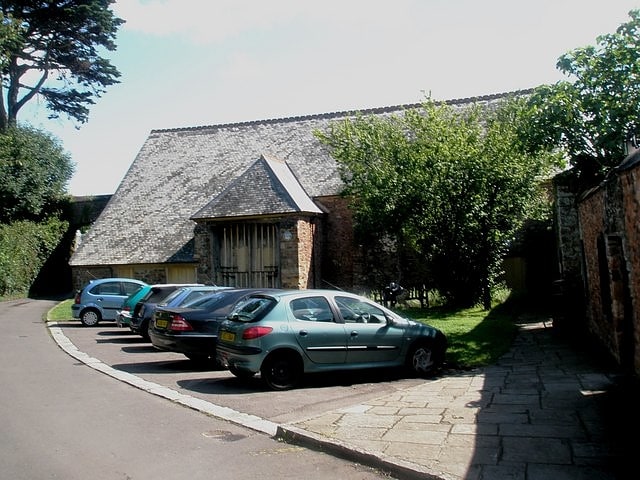
Event venue in Dunster, England. The Tithe Barn is a 14th-century tithe barn in Dunster, Somerset, England.
It has a cruciform plan. The east front has central double doors in heavy oak with a chamfered frame. It is a grade II listed building.
The barn, which was originally part of a Benedictine Dunster Priory, has been much altered since the 14th century and only a limited amount of the original features survive. In the "Valor Ecclesiasticus" of 1535 the net annual income of the Dunster Tithe Barn is recorded as being £37.4.8d (£37 23p), with £6.13s7d (£6.68p) being passed on to the priory in Bath.
The Somerset Buildings Preservation Trust (SBPT) has co-ordinated a £550,000 renovation project on behalf of the Dunster Tithe Barn Community Hall Trust (DTBCHT), into a multi-purpose community hall under a 99-year lease at a pepper-corn rent, by the Crown Estate Commissioners who own the building. Funding has been obtained from the Heritage Lottery Fund and others to support the work.[10]
Address: Priory Green, Dunster
Black Ball Camp
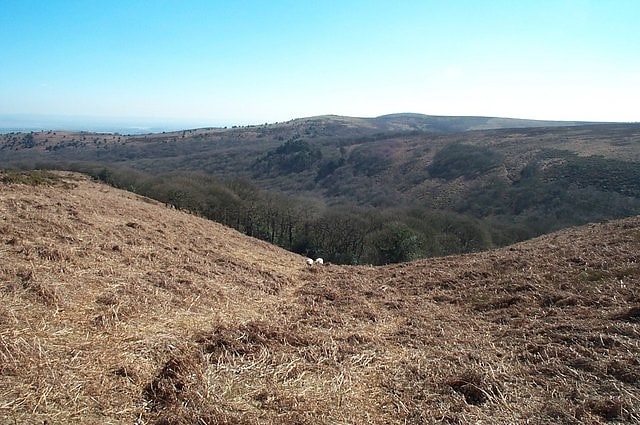
Black Ball Camp is an Iron Age hill fort South West of Dunster, Somerset, England on the northern summit of Gallox Hill. It is a Scheduled Ancient Monument.
It is also known as British Camp and is possibly associated with Bat's Castle. It has a 3 metres (10 ft) high rampart and a 2 metres (7 ft) deep ditch. At the beginning of the 20th century the foundations of a stone tower were visible however this is no longer present.[11]